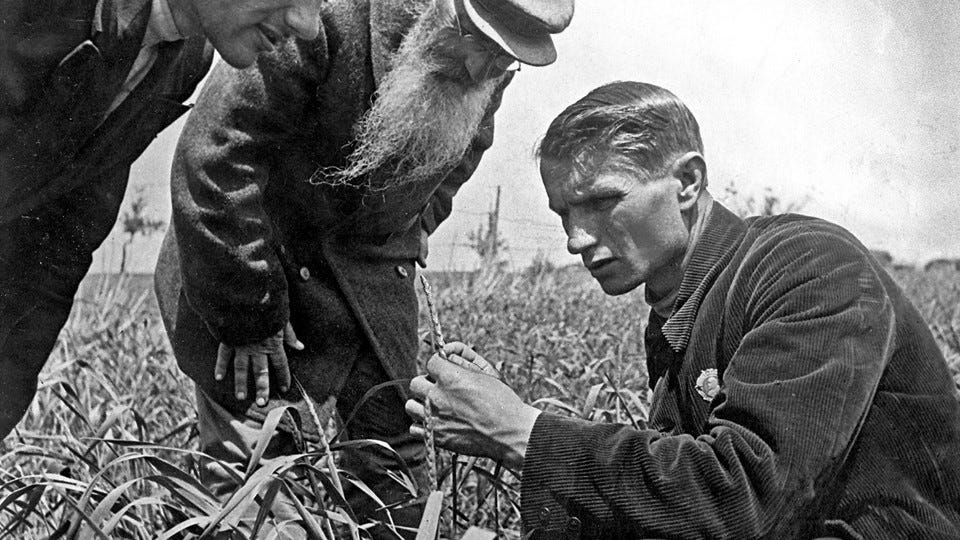Hello Interactors,
We’re staying in Russia this week because the United States sticks with Russia. At least they used to. And boy did they need it. The famines that have swept through that region over the years have taken the lives of tens of millions of people. Even though Russia was home to the world’s leading seed expert. But the U.S. was always there to bail them out. If the U.S. fell into a food crisis, would Russia return the favor?
As interactors, you’re special individuals self-selected to be a part of an evolutionary journey. You’re also members of an attentive community so I welcome your participation.
Please leave your comments below or email me directly.
Now let’s go…
SEEDS OF CHANGE YIELDS DEEDS OF THE DERANGED
Joseph Stalin liked Trofim Lysenko. He grew up poor far away from Moscow just like him. Stalin was from Georgia and Lysenko Ukraine. Both identified as proletariats. They despised the bourgeoisie imperialistic West. Including highly educated and trained scientists. Lysenko was a horticulturist, studied agricultural, and then worked in the department of physiology at the Ukrainian Genetics Laboratory. But he wasn’t like other scientists.

He devised his own homegrown, unproven experiments. He invented theories with pseudo-scientific names like “jarovization” or “vernalization” from Latin’s ‘vernum’ or spring. His claims became known as “Lysenkoism.” Other Russian scientists looked the other way. Russia’s most respected biologist, geneticist, and geographer, Nikolai Vavilov, thought Stalin’s new friend was a crackpot. It wouldn’t end well.
Lysenko got lucky with ‘vernalization’. He tricked wheat seeds into blooming early by treating them with moisture in cold temperatures as a way to produce yields in the spring. The trick had already been performed by American John Hancock Klippart in 1857, but Lysenko gave it a name. He also believed the deceived seeds from these plants would magically inherit the ability to do the same on their own.
His theory ran counter to empirical evidence and to the knowledge and experience of Vavilov. Vavilov worried Lysenko’s tricks, unproven theories, and over promises to Stalin and the Soviet government could lead to catastrophic errors and the worsening of the routine famines Russia was trying to escape.
But Stalin embraced Lysenko’s folksy and unorthodox ways. He believed in his salt-of-the-earth intuition and grew suspicious of the world-renowned and respected science of Nikolai Vavilov. Vavilov was the winner of the Lenin Prize, one of the most prestigious awards in science, and was respected worldwide. He traveled the globe successfully identifying the geographic genetic origins of cultivated plants. He guest-lectured and rubbed elbows with those Western imperialists Stalin despised. Vavilov also spoke poorly of the former Ukrainian peasant come pseudo-scientist Stalin had grown fond of.
In 1936 Stalin replaced Vavilov with Lysenko as the head of the Soviet Academy of Agriculture. Six years later, in 1941, Stalin sentenced Vavilov to execution on claims he was trying sabotage Stalin’s agricultural plans. His sentence was then reduced to a prison term. Vavilov, who grew up fearful of starvation in a village prone to crop failures and food rationing – a scientist who dedicated his life to eradicating famine – died in prison in 1943 of starvation.
Famines had been ravishing Russia for a century already. The large-scale farm practices of today started in the nineteenth and twentieth centuries. But missteps led to widespread famine, displacement, and environmental damage. Technological advancements allowed expansive grasslands to be converted to cropland around the world, including Russia, Australia, Argentina, South Africa, Canada, and the United States.
An explosion of European immigrants to the United States in the mid 1800s, together with The Homestead Act of 1862, pushed immigrants into prairies to the West and North. Some ventured into Canada. The Civil War ended in 1865 and four years later the Transcontinental Railroad was completed. Both increased the number of agrarian colonizers to the Great Plains.
But the climatic patterns in these areas played a role in the evolution of these plains. The grasslands are arid with periods of intense rainfall followed by drought. Settlers could be deceived into believing these rainfalls were routine only to witness periods of extreme drought. Farmers in the 1870s and 1880s witnessed regular rainfall only to see it disappear in the 1890s. Instead of consulting with Indigenous farmers on how they farmed the land for millennia, the colonists instead expanded area croplands and intensity to make up for short yields. Some used the land to graze cattle leading to even more elimination of the natural grasses needed to nourish and sustain the soil.
The U.S. government accelerated farm expansion by altering the Homestead Act to include larger plots of land. The rain returned in the 1920s which attracted another wave of farmers. Farmland in a section of northwestern Texas and eastern New Mexico doubled in the two decades between 1900 and 1920 and tripled in just five years between 1925 and 1930.
Russia saw similar expansions of large-scale agriculture. In the late 1800s and early 1900s, groundbreaking research by soil scientist and geographer Vasilii Dokuchaev, the father of soil science, revealed for the first time the role climate and topography play in soil health. He went on to develop the world’s first soil classification system. Some farmers, including immigrant German Mennonites, adopted drought tolerant farming practices Dokuchaev recommended.
Meanwhile, most of Russia, like the United States, continued large-scale overly intensive farming techniques – though Russia lagged in mechanization. Both the United States and Russia, set on expansion, growth, and domination, gambled with the climate, soil, plants, and the crops they yielded. They ignored both emerging science and age-old sustainable practice that likely would have mitigated inevitable crop failure, famine, and long-lasting and long-ranging environmental and social devastation. Destruction so severe they compounded the effects of natural disasters.
Between 1921 and 1923 extreme droughts and winters led to plant disease, insect infestation, and soil erosion throughout the converted grasslands of Russia, Ukraine, and surrounding regions. Famine ensued causing millions to die of starvation. Ravaged by WWI and the Russian Civil War, the Soviet government, then under Vladimir Lenin, was forced to import food and organize relief efforts.
In 1921 Lenin called on the United States to help. The American Relief Administration, headed by future President Herbert Hoover, employed 300 Americans and a 120,000 Russians to provide relief. It was an extension to European relief from WWI. They provided daily meals for over 10.5 million people while also administering medical aid to typhus sufferers – a feverish epidemic claiming even more Russian lives.
GO GREEN
The relief from America worked. By 1923 the Soviet government was able to stockpile enough grain to organize their own relief efforts and the U.S. stepped away. But Russia continued to be hit with episodes of drought. In 1924 another wave hit and the Soviets were once again forced to organize relief efforts. Again, they stockpiled enough to make it through 1925 and 1926 only to be hit again in 1928. Convinced traditional farming techniques were unsustainable, the Soviet government initiated programs that mimicked industrialized farming techniques in the United States.
Another drought came in 1931 and 1932 and with it more famine. Joseph Stalin had risen to power amidst the Russian Revolution. Unlike Lenin, he refused support from the outside. By 1933, when food stocks began to rise again four million more people had died from famine. But the United States would have been in no position to help this time anyway. In 1930, widespread drought spread through the Great Plains stretching from Canada to Mexico.
The natural grasses that once protected soil from blowing away had either been tilled for crops or consumed by cattle. The Industrial Age had given way to industrial farming. A substantial gamble with colossal consequences. The Dust Bowl, or Dirty Thirties, a natural disaster compounded by poor agricultural practices and imperialist hubris, impacted over 100 million acres. It intensified the Great Depression. If the dust storms didn’t destroy homes and farms, failed mortgages and loans did. Between 1930 and 1940 nearly 3.5 million people evacuated the lands they had only recently colonized and practically destroyed. Including their native inhabitants.

Meanwhile, back in Russia, Stalin made another gamble in 1936. He bet on “Lysenkoism”. He believed it would solve the Soviet agricultural malaise sending the one man capable of potentially solving the region’s, maybe the world’s, agricultural problems to starve to death – Nikolai Vavilov. But soon came WWII and more geopolitical disruption in a Soviet Union still trying to figure itself out. And then, in 1946 and 1947, another Russian famine emerged. Again, Stalin refused aid and two million more died of starvation.
But little did Stalin know, many of the scientists that worked under Vavilov had hidden his seed collection and continued to conduct experiments in private. One esteemed plant breeder, Pavel Luk’ianenko, drafted off the work of Vavilov and bred a variety of semi-dwarf wheat seeds in 1950 that would change the course of Russian agriculture forever. By the time of his death in 1972 he was credited with breeding or co-breeding 15 different varieties of regionalized winter wheat seeds.
His work was Russia’s contribution to a larger global Green Revolution, a systematic and coordinated effort in the 1950s and 1960s between genetically modified seed breeding, chemical fertilizers, land use policy, public and private capital, and mechanized technology that massively increased crop yields. The American scientist and Nobel Prize winner credited with birthing this revolution, Norman Borlaug, said in 2000 that
“Had the global cereal yields of 1950 still prevailed in 1999, we would have needed nearly 1.8 billion hectares of additional land of the same quality – instead of the 600 million that was used – to equal the current global harvest".1
After Stalin’s death in 1953, Nikita Khrushchev rose to power. Khrushchev was Russian but had ruled Ukraine for a decade. He witnessed struggling farmers endure famine and invented what he called “agro-towns” – small villages in remote rural areas with a library and stores where farmers could live and be better supported. But during the drought of 1946, he had to beg Stalin for aid after over-estimating Ukrainian crop yields. It was a fissure that cost him his post in Ukraine. However, his dismissal led to a position in Moscow closer to Stalin that surely cemented his rise to power seven years later.
One of Khrushchev’s first programs was “Virgin Lands”. He proposed the conversion of 25 million hectares of arid grasslands to croplands in Siberia and Kazakhstan. Within a year this region became a significant contributor to Soviet grain yields. But they soon diminished and in 1962 and 1963 came another drought. In an echo of the Dust Bowl, winds picked up and blew away most of the topsoil that had previously been secured by grassland. Again, a massive shortfall of wheat forced Khrushchev to seek foreign aid. Ten million tons of grain were imported from Canada and the United States. Quantities of this magnitude were likely the result of the crop yield successes of the Green Revolution. But they were also making up for the environmental failings of the Green Revolution.
NUT JOB
It can be hard accepting curses that can come with blessings. Such is the damaging and delicious duality of modern agriculture. We can’t seem to live with it, and we don’t dare try to live without it. But we do have a choice over how large-scale agriculture is implemented. This is unlike the effects of climate change where we can’t live with them, and we don’t have a choice to live with out them.
These historical environmental extremes that plagued the former Soviet agricultural lands continue to this day. In 2009, Russia was on course to export record amounts of grain. Then, in 2010, a wildfire brought on by severe drought turned acres of golden grain to ash. Vladimir Putin was forced to cancel exports. And like those before him, was forced to import food to stave off widespread famine.
Russia, Ukraine, Kazakhstan, and other surrounding countries continue to adjust to extreme weather patterns. Still, much of that ‘Virgin Land’ once converted to cropland over the past 50-60 years has been abandoned due to soil depletion brought on by large-scale intensive factory farming. Just a small fraction of the original ‘Virgin Lands’ are farmed in Kazakhstan today. But they continue to learn and adjust…as we all must.
The effects of climate change are global in scale, but differ in variety, intensity, and regularity at a regional and local level. So does the impact on people and place. As a result, responses to these effects must also differ in variety, intensity, and regularity. But intent matters. I’m convinced scientists like Vavilov, Lysenko, Luk’ianenko, and Borlaug were intent on saving people from starvation. They all witnessed firsthand real suffering of starving individuals and the loss of entire populations.
But I’m less convinced of the intentions of politicians like Stalin and Putin. I’m also skeptical of the intentions of Western coalitions backed by corporations who prioritize capital, political control, and short-term quarterly earnings. They seem more intent on feeding growing GDP figures than the starving figures of the emaciated. Stuff pockets of greed over hungry mouths to feed. Let the soils blow away, so long as the board boosts my pay. Shrink operating expenditures amidst rising temperatures. Large-scale government schemes feed delusional utopian dreams. Avoid political disruption by funding criminal corruption. Intention matters.
As an example, in 1947 the British Government wanted to increase peanut production to sell as oil on the world market. So, together with Unilever, then went to the East Africa territory of Tanganyika to convert the wooded plains to peanut farms. An area England had militarily occupied since 1916. No one involved in the project bothered to study the soil and topography. They had to remove Mvule trees to make way for croplands, but they didn’t account for their deep, stubborn, thirsty roots. Their tractors were ruined in the process. New tractors damaged the soil with their weight. Their engines were too weak to churn the hard soils.

In two years, they had only cultivated 16% of what they had planned. By 1951 the British government called it quits. They had spent six times the value of the crops they had grown. The director of the program was a former Russian who applied techniques of his communist past. Leaders at Unilever demanded immediate results to fit their revenue goals. Both of their approaches were insensitive to local people and place leaving it ravaged as they wrote off the loss and flew away amidst the arid soil they had unearthed. They abandoned the people and place most impacted by their imperialistic Groundnut Scheme.
A railroad was constructed to ship the elusive nuts to a harbor the British had built so they could float nut oil around the world. The port remains, but the rail was dismantled. The global transportation network is what allows those locally impacted by natural disasters to receive aid. Parts of Africa continue to be cut off from these networks.
But it were not for these networks, millions more would have died of starvation over the past 200 years. The U.S. and Ukraine blame Russia for clogging those very networks today. Meanwhile, Putin blames the West for blocking fertilizer and grain imports into Russia. Both are true. And it’s also true that Russian wheat exports were up 80% in April over last year and rose 27% in May. They just may be the winner in Wheat sales this year, unless another drought hits and the fields turn to fire. But if Russia was hit with a famine inducing drought, would Putin ask Ukraine and the West for relief? Would America offer relief? What if America is hit with a famine inducing drought? Would China and Russia come to our aid?
On June 27th, President Biden and members of the G-7 met in Austria to discuss a plan to massively invest in infrastructure throughout the developing world. They aim to thwart nonmembers like China and Russia from introducing future disruptions by controlling more infrastructure, like transportation. It’s a response to China’s Belt and Road Initiative. Biden said,
“This isn’t aid or charity, it’s a chance for us to share our positive vision for the future…because when democracies demonstrate what we can do, all that we have to offer, I have no doubt that we will win the competition.”
That hubris reminds me of the British Groundnut Scheme. Will the West be applying lessons learned from the devastating and deleterious effects of centuries of colonization? Are leaders any more sensitive to the needs and desires of the local people and places these schemes are sure to impact? These investments are long overdue, and China has a head start, but they must be done with the right intentions.
Lack of adequate adoption of agricultural practice and needed infrastructure is what leaves regions most vulnerable to the negative agricultural effects of climate change. The way our food is produced, distributed, and sold heavily relies on transportation networks. The millions of people who were saved from starvation in the former Soviet Union is testimony to this fact. But responses also require acknowledgment, understanding, and support of local people and place…and their governments. Whether they share a common vision with the West or not.
People situated in their places possess the necessary local and practical knowledge and ingenuity needed to augment the abundance of science that rests on centuries of historical successes and failures. Capital investment from the West is needed and necessary, but not sufficient or welcomed should the intent be to strengthen power, bolster profits, and exploit people and land. In other words, to repeat history. To learn the lesson, past sins must not be repeated. Instead of killing people, animals, and plants in the interest of political ideology, we should seek their engagement and invest in their ecology. In the words of Nikolai Vavilov in 1932, nine years before Stalin issued his execution sentence:
“Many historical problems can be understood only because of the interaction between man, animals and plants.”2
"The green revolution revisited and the road ahead". Norman Bolaug. Stockholm, Sweden. 2000.
Origin and Geography of Cultivated Plants. N. I. Vavilov, Mykola I. Vavylov, Níkolaj Ívanovítsj Vavílov, Vladimir Filimonovich Dorofeev. 1992.
Primary Reference:
Lessons from the Past: A Historical Overview of the Place-Food Relationship. Mark B. Tauger. Chapter 3 of. A Place-Based Perspective of Food in Society. 2015.
















Share this post